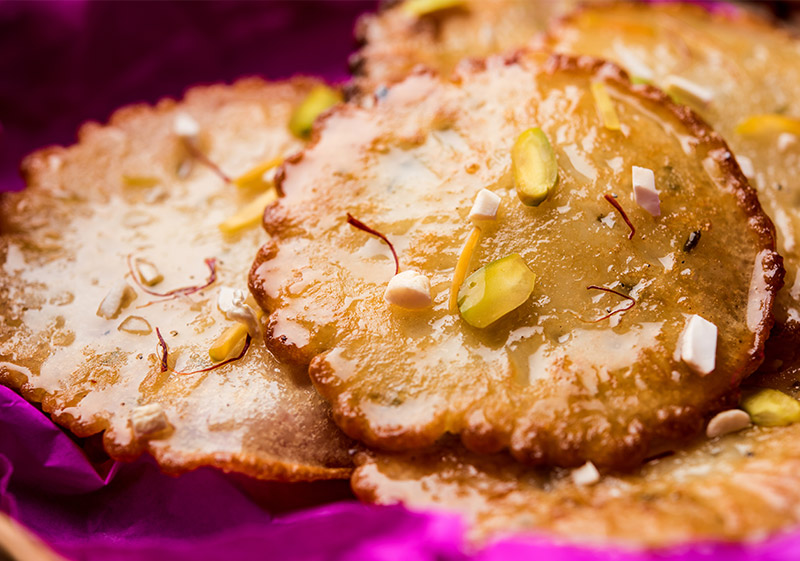5 mins November 29, 2019
It may not be exactly what the doctor ordered but tucked between those deep-fried and sugary layers of malpua are pieces of the multi-layered story of the subcontinent. This palm-sized pancake, soaked in syrup, garnished with dry fruit and served
with a side of rabdi or clotted cream is popular in India, Bangladesh, Nepal and Pakistan. It is also the oldest known dessert in India.

The earliest reference to malpua goes back 3,500 years, to the Rig Veda that calls it ‘apupa’. In Vedic times, apupa was made from barley flour, not rice or wheat flour, as barley was the primary grain consumed during that time. Rice
and wheat flour were used to make this sweetmeat much later. The barley mix was then fashioned into flat cakes, fried in ghee or boiled in water and then dipped in honey before serving.
During its journey from apupa to malpua, there are many references to this sweetmeat and its changing composition, from the Rig Vedic period around 1500 BCE to the Gupta period in 400 CE. Primarily served to welcome guests, apupa finds mention
in Buddhist and Jain canonical literature, and later Vedic texts like the Upanishads and the Brahmanas. All these works mention its preparation, and there is even a reference to it being fried in ghee or clarified butter before being mixed
with intoxicating soma juice, a ritualistic drink in Vedic times.
In the 2nd century CE, apupa morphed into a more nuanced dessert, and literature from this period refers to its preparation from wheat flour, milk, ghee, sugar, ginger and spices such as cardamom and pepper. Pupalika was a small cake of rice or
wheat fried in ghee with jaggery inside. Stuffed apupas were also common back then. Over the centuries, apupa incorporated many more cultural influences and was embraced by different faiths. A version of this dessert, with eggs and mawa, was
a popular sweet in Islamic courts.
In Odisha’s famous Jagannath temple at Puri, malpua is an early morning offering made to the main deity, Lord Jagannath. Amalu (malpua) is a Chappan Bhoga, the traditional food offered daily to Lord Jagannath. In West Bengal, malpua is prepared
in winter with pithley, a Bengali sweet. It is also relished in Nepal during the festival of Holi.
[Also Read: Jalebi - Swirls of History]
Variants of the sweetmeat add cubed and diced pineapple and mango to the mix, while in Bangladesh, the recipe calls for crushed, ripe banana or coconut. But malpua in North India, especially in Uttar Pradesh, Rajasthan and Bihar, never contains
fruit.
During the holy month of Ramadan, malpua is part of the iftar, the meal that breaks the fast. The recipe usually incorporates maida, rawa, and khoya/ mawa (milk solids), lending it an especially rich flavour.
Watching malpua being deep-fried in giant vats, glistening in ghee, soaked in syrup and then expertly flung like oversized frisbees onto a heap is a feast for the senses. For authentic malpua when in Mumbai, head to Mohammad Ali Road. Today, you
can find the malpua on the menu of several high-end restaurants, too. If you are in the mood to indulge your sweet tooth, check out the deals and discounts offered by Axis Bank’s Dining Delights.
The recipe for malpua has proved robust and versatile, constantly adapting to the cultural needs and palates of different peoples. It is only fitting that India’s oldest known dessert is also its most unifying sweetmeat in a land of great
diversity.
Disclaimer: This article has been authored by Live History India Digital, a Mumbai based Digital Content Company. Axis Bank doesn’t influence any views of the author in any way. Axis Bank & Live History India Digital shall not be responsible for any direct / indirect loss or liability incurred by the reader for taking any financial decisions based on the contents and information. Please consult your financial advisor before making any financial decision.


















